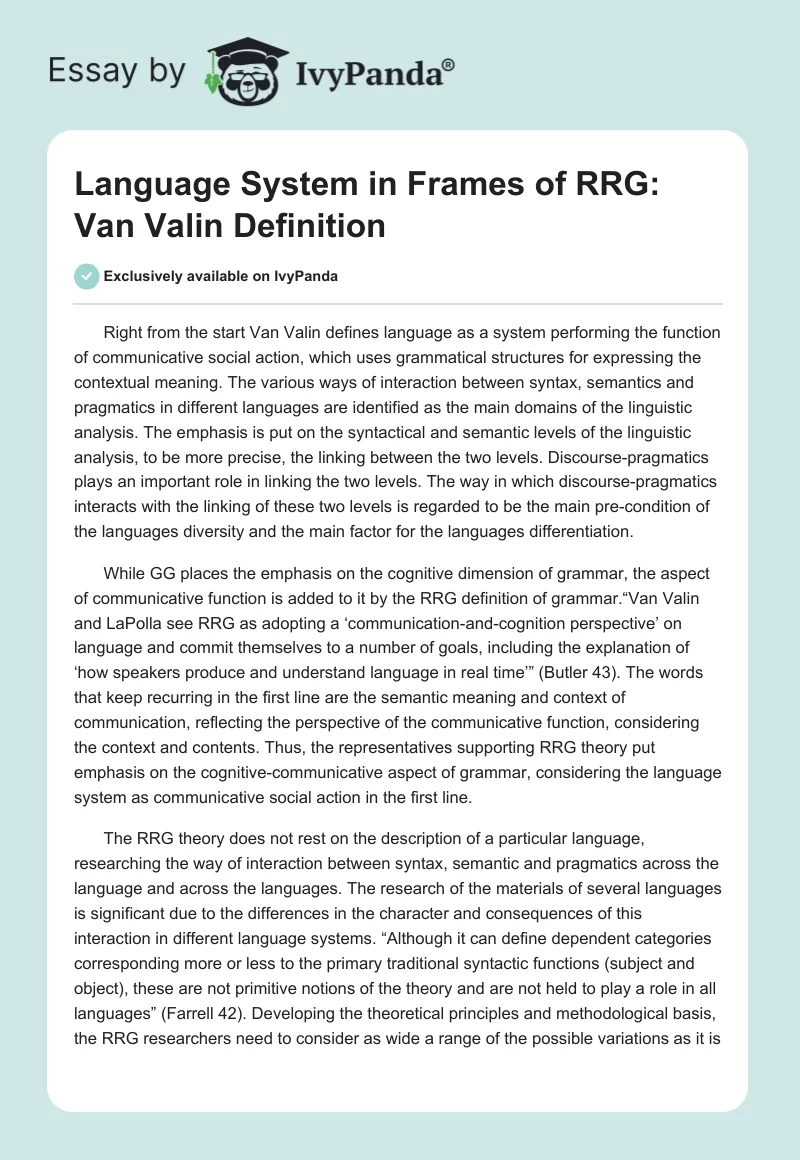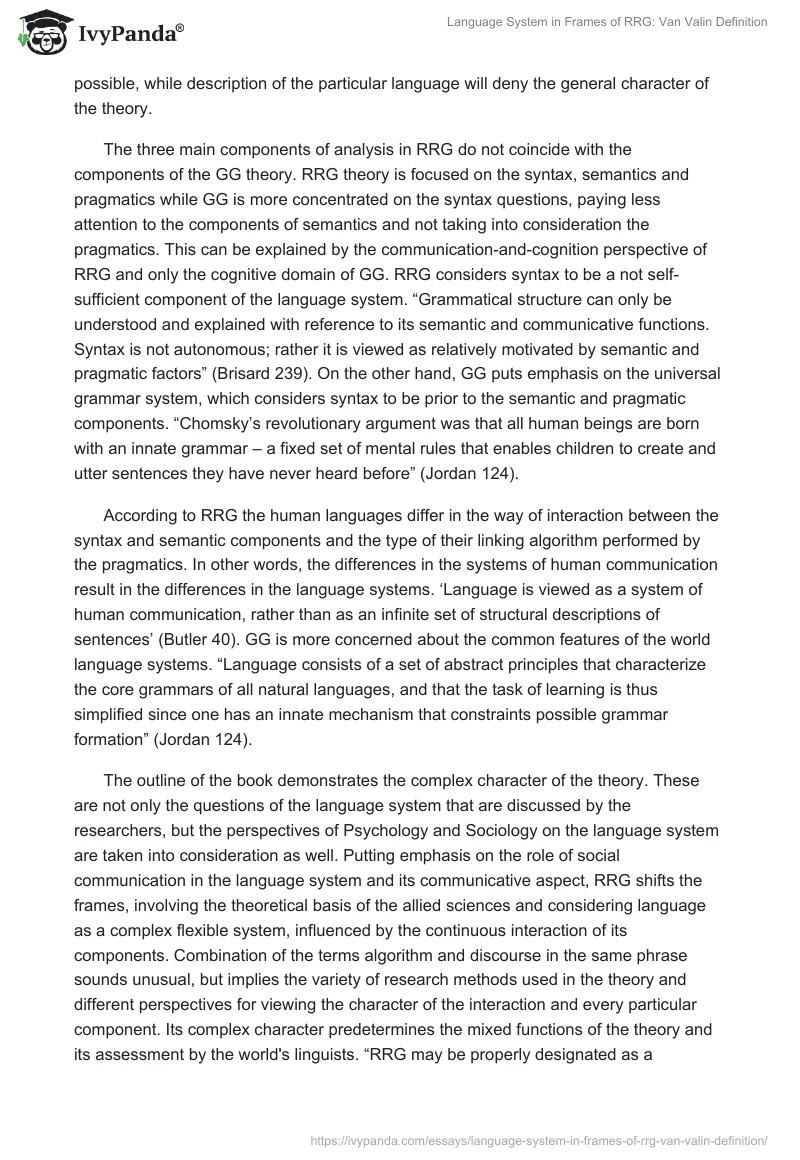Right from the start Van Valin defines language as a system performing the function of communicative social action, which uses grammatical structures for expressing the contextual meaning. The various ways of interaction between syntax, semantics and pragmatics in different languages are identified as the main domains of the linguistic analysis. The emphasis is put on the syntactical and semantic levels of the linguistic analysis, to be more precise, the linking between the two levels. Discourse-pragmatics plays an important role in linking the two levels. The way in which discourse-pragmatics interacts with the linking of these two levels is regarded to be the main pre-condition of the languages diversity and the main factor for the languages differentiation.
While GG places the emphasis on the cognitive dimension of grammar, the aspect of communicative function is added to it by the RRG definition of grammar.“Van Valin and LaPolla see RRG as adopting a ‘communication-and-cognition perspective’ on language and commit themselves to a number of goals, including the explanation of ‘how speakers produce and understand language in real time’” (Butler 43). The words that keep recurring in the first line are the semantic meaning and context of communication, reflecting the perspective of the communicative function, considering the context and contents. Thus, the representatives supporting RRG theory put emphasis on the cognitive-communicative aspect of grammar, considering the language system as communicative social action in the first line.
The RRG theory does not rest on the description of a particular language, researching the way of interaction between syntax, semantic and pragmatics across the language and across the languages. The research of the materials of several languages is significant due to the differences in the character and consequences of this interaction in different language systems. “Although it can define dependent categories corresponding more or less to the primary traditional syntactic functions (subject and object), these are not primitive notions of the theory and are not held to play a role in all languages” (Farrell 42). Developing the theoretical principles and methodological basis, the RRG researchers need to consider as wide a range of the possible variations as it is possible, while description of the particular language will deny the general character of the theory.
The three main components of analysis in RRG do not coincide with the components of the GG theory. RRG theory is focused on the syntax, semantics and pragmatics while GG is more concentrated on the syntax questions, paying less attention to the components of semantics and not taking into consideration the pragmatics. This can be explained by the communication-and-cognition perspective of RRG and only the cognitive domain of GG. RRG considers syntax to be a not self-sufficient component of the language system. “Grammatical structure can only be understood and explained with reference to its semantic and communicative functions. Syntax is not autonomous; rather it is viewed as relatively motivated by semantic and pragmatic factors” (Brisard 239). On the other hand, GG puts emphasis on the universal grammar system, which considers syntax to be prior to the semantic and pragmatic components. “Chomsky’s revolutionary argument was that all human beings are born with an innate grammar – a fixed set of mental rules that enables children to create and utter sentences they have never heard before” (Jordan 124).
According to RRG the human languages differ in the way of interaction between the syntax and semantic components and the type of their linking algorithm performed by the pragmatics. In other words, the differences in the systems of human communication result in the differences in the language systems. ‘Language is viewed as a system of human communication, rather than as an infinite set of structural descriptions of sentences’ (Butler 40). GG is more concerned about the common features of the world language systems. “Language consists of a set of abstract principles that characterize the core grammars of all natural languages, and that the task of learning is thus simplified since one has an innate mechanism that constraints possible grammar formation” (Jordan 124).
The outline of the book demonstrates the complex character of the theory. These are not only the questions of the language system that are discussed by the researchers, but the perspectives of Psychology and Sociology on the language system are taken into consideration as well. Putting emphasis on the role of social communication in the language system and its communicative aspect, RRG shifts the frames, involving the theoretical basis of the allied sciences and considering language as a complex flexible system, influenced by the continuous interaction of its components. Combination of the terms algorithm and discourse in the same phrase sounds unusual, but implies the variety of research methods used in the theory and different perspectives for viewing the character of the interaction and every particular component. Its complex character predetermines the mixed functions of the theory and its assessment by the world’s linguists. “RRG may be properly designated as a structural-functionalist theory, rather than purely formalist or purely functionalist” (Brisard 239).
Bibliography
Brisard, Frank, Jan-Ola Ostman, and Jef Verschueren. Grammar, Meaning and Pragmatics. John Benjamins Publishing Company, 2009: 308.
Butler, Christopher. Structure and Function: A Guide to Three Major Structural-Functional Theories. Studies in Language Companion Series, 2003: 570.
Farrell, Patrick. Grammatical Relations. Oxford University Press, 2005: 327.
Jordan, Geoff. Theory Construction in Second Language acquisition. John Benjamins Publishing, 2004: 294.
Littlejohn, Stephen. Theories of Human Communication. Wadsworth Group, a Division of Thomson Learning, 2003: 378.


